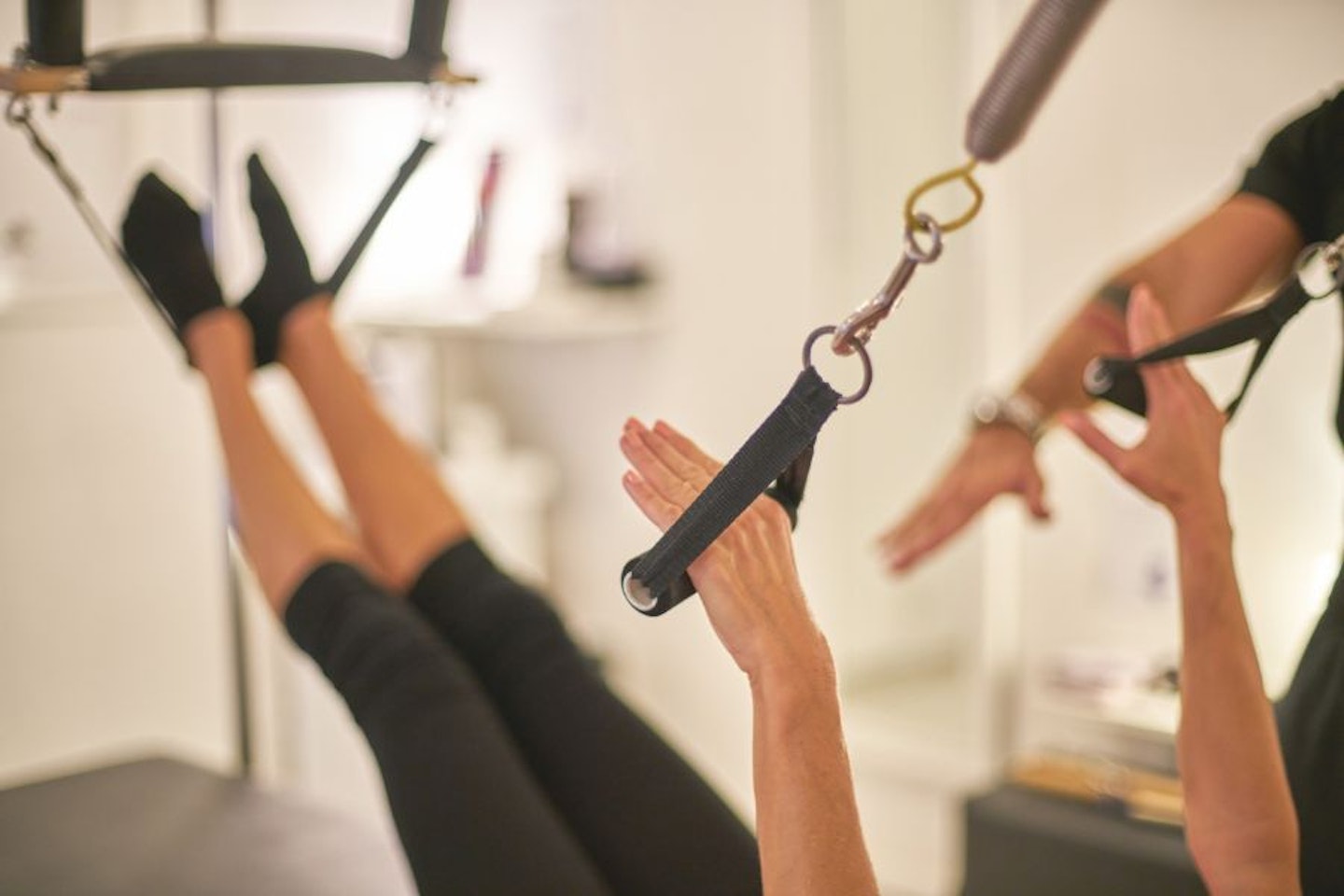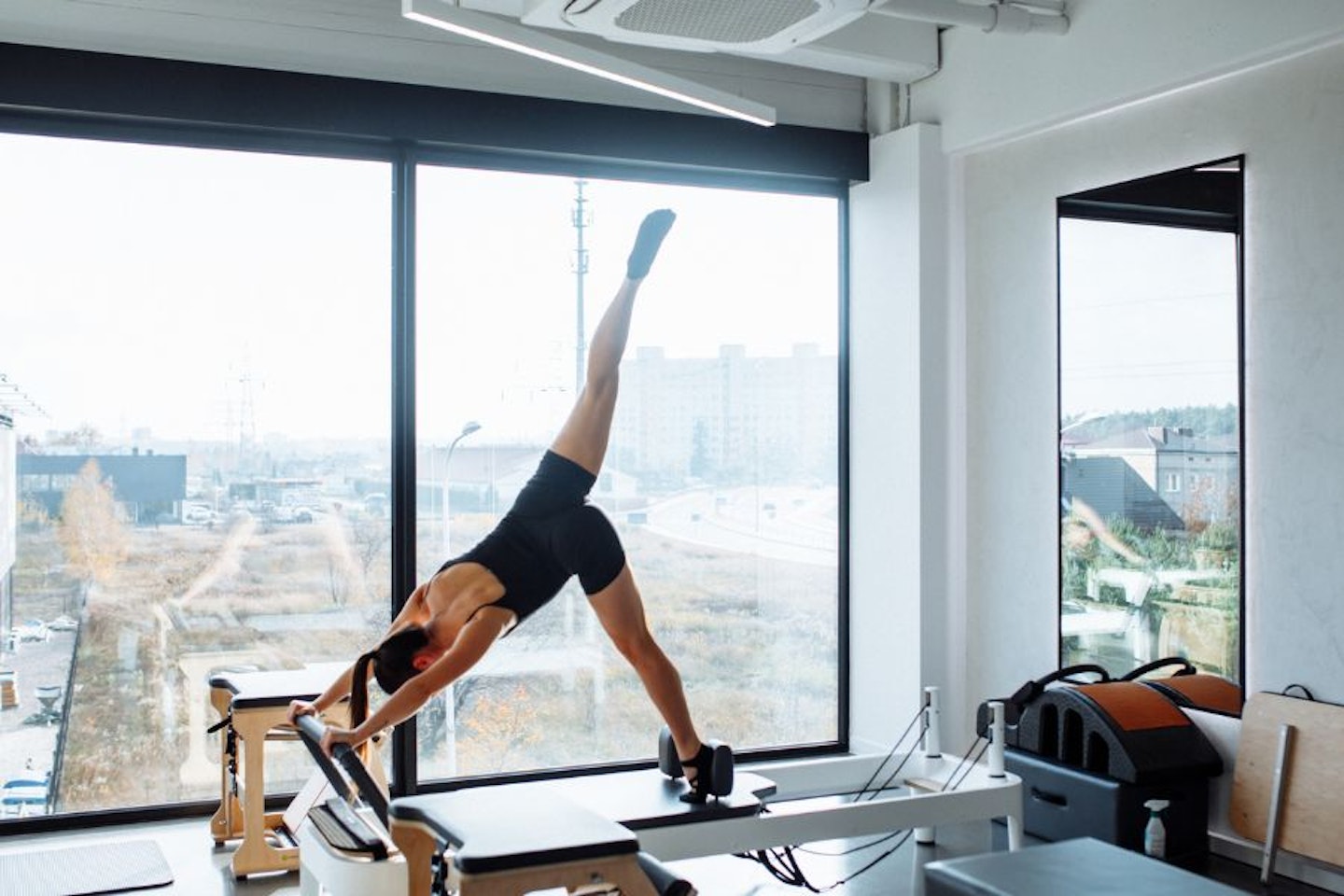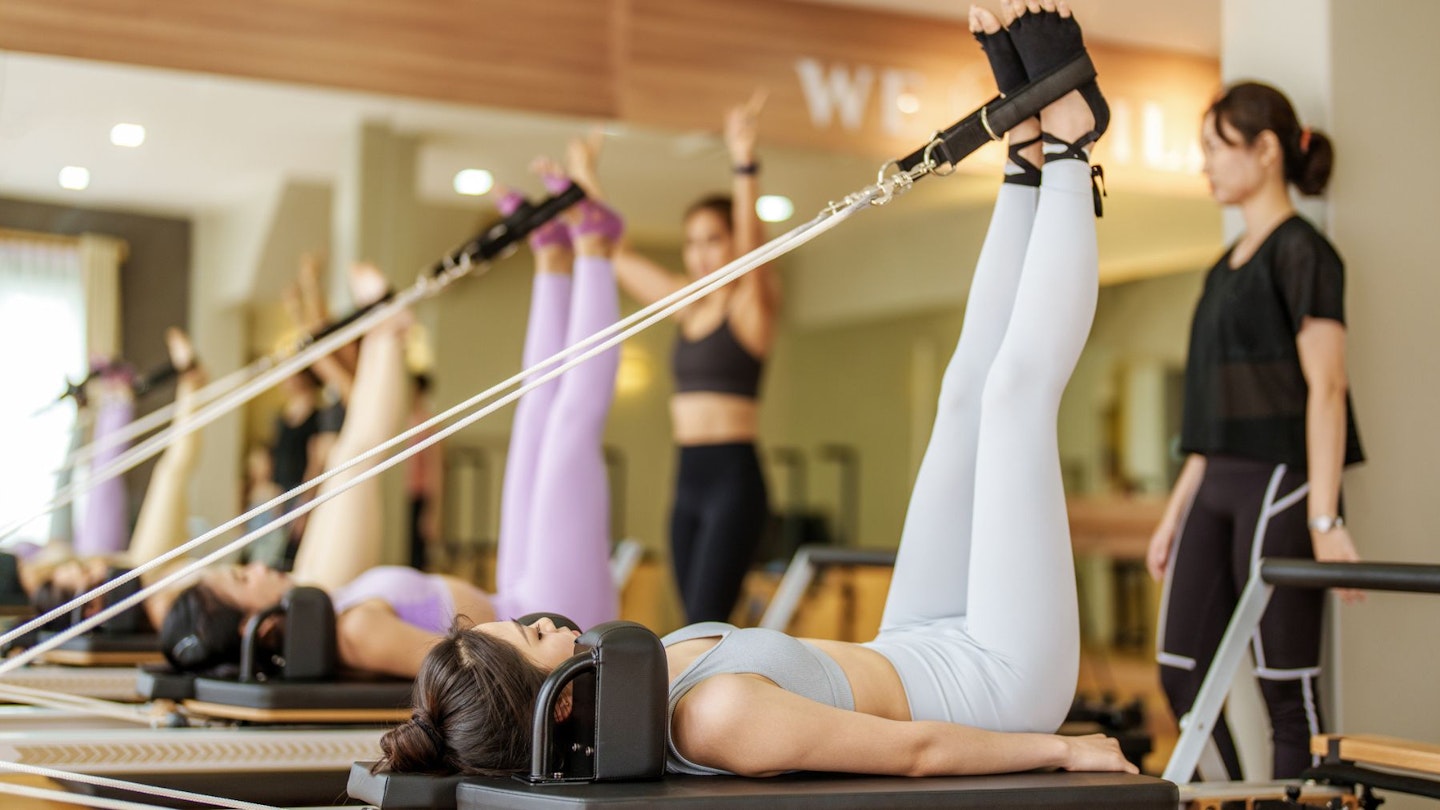So you're gearing up for a session on the sleek, spring-loaded contraption, aka the Reformer and you want to know exactly what you're in for during your Reformer Pilates class. There's certainly more to it than just stretching on a fancy bed with pulleys.
The Reformer shouldn't be seen as a scary contraption. In fact, it's great for offering additional support through its resistance, as well as improving your flexibility and posture. Yes, the machine can be quite a complex one to use, but once you've got the hang of it there's really nothing to be worried about.
"Reformer Pilates is traditional Pilates but reimagined, thanks to the use of a specialised machine called a Reformer which enhances control and resistance," says Jade Winter, Co-Founder and CEO of Studio Pilates International - but it's actually been around since the early 1900's. "Reformer Pilates was first introduced during World War I, thanks to Joseph Pilates where he devised a system to assist bed-bound patients improve their movement by attaching springs to their hospital beds and creating resistance exercises without them having to stand up."
Now, loved by the likes of Meghan Markle, Margot Robbie and even Harry Styles, "Reformer Pilates is now more popular than ever with Pilates bookings increasing by 92%," Jade says.
But, you don't have to be a celebrity to take part. Reformer Pilates classes are offered in studios across the globe and are suitable for anyone of all fitness levels and ages. "Because of the individual attention with a qualified instructor, a Reformer Pilates class can suit everybody from elite athletes to people with limited mobility, pregnant women and people with low fitness levels," Jade says. "Plus, Pilates helps manage chronic pain, improves posture, and enhances overall wellbeing."
She also adds that "the workout is also ideal for older adults as it helps to combat muscle loss and enhances balance and coordination, which is great because falls are a concern for older adults."
How the Pilates Reformer machine actually works
The Reformer is made up of a cushioned, mobile carriage with added shoulder blocks for stability. Underneath the front platform lies the magic to the Reformer - a set of springs that change the resistance - think almost like a Pilates band but on a bigger scale. Now you will have to change these springs throughout your class, but your instructor will announce any changes to the spring resistance.
The next challenge is the resistance straps. These straps, usually long and short, are strategically placed to target different muscle groups - the shorter strap is better for heavier tension and the longer strap is for more traditional mat Pilates exercises.

What are the benefits of Reformer Pilates?
"The benefits go far beyond physical, and the fact that Reformer Pilates can be done by almost anyone is a huge benefit, too," Jade says. There are more than just three benefits of Reformer Pilates, in fact, there's a whole host of them. But here are the key ones.
Toning muscles
Unlike more conventional workouts, the Reformer's design incorporate adjustable strings, and "by using resistance and controlled movements, participants can sculpt and tone their bodies while enhancing overall function," Jade says. This is because the nature of Reformer Pilates is to not only target major muscle groups, but also help to stabilise muscles. With consistent practice this will result in a balanced physique, capable of executing movements with grace and precision.
Building strength
Reformer Pilates isn't just about stretching and toning muscles; it's also a powerhouse for building strength too. Imagine a workout that targets your muscles from all angles - that's exactly what the Reformer table does. Think of it as giving your body a tune-up, strengthening your core, legs, arms and back.
Increasing flexibility
If flexibility is an element of your fitness that you're wanting to work on Reformer Pilates is perfect for gently elongating and stretching your muscles. This will very gradually expand their range of motion, and joints may even become more pliable.

Is Reformer Pilates harder than regular Pilates?
Reformer Pilates often gets dubbed as 'harder' because it introduces a whole new dimension of challenge through the use of the machine - unlike mat Pilates, which uses body weight for resistance. Jade explains: "whilst Reformer Pilates might be perceived more challenging than regular Pilates, it’s still a low-impact, full-body workout that incorporates controlled movements and is a more modern form of Pilates that delivers results sooner."
Some may find the resistance of the Reformer invigorating, "the versatility of the Reformer allows you to be more strategic in focusing on certain muscle groups and the addition of resistance springs makes it easy to level up your workouts when you’re ready," Jade says. Meanwhile others may prefer the simplicity of mat Pilates.
What is the most common mistake people make when they start Reformer Pilates?
If you're going to begin Reformer Pilates, you're going to want to know how to use the machine first. Jade points out that the most common mistake a Pilates-newbie can make is to use the Reformer machine unsupervised. "We would always recommend attending a class with a qualified instructor so that they are there to give their expertise and make sure that you maintain the right form and alignment." Otherwise, she continues: "you won’t see the real benefits and it will also help to prevent injury."
Gearing up for a Reformer class
The most important thing (well, maybe not the most important) to think about before getting up and heading to your Reformer Pilates class is what you're going to wear. The attire for Pilates is not as inflexible as some workout classes and don't require any particular trainers as you'll take them off anyway.
For Pilates it's a good idea to wear something you can move around freely in, like a good pair of leggings, a supportive sports bra or tight-fitting cycling shorts. Also don't forget your Pilates grippy socks as these will help you more than you think - they're similar to the style of yoga socks.
In terms of what to pack in your gym bag for your first class, here's a list of the necessities:
• Water bottle
• Clean socks, preferably with grippy soles
• A gym hoodie or workout jacket for pre and post-workout
• Hair bobble
• Towel
• Post-workout snack (trust us, you'll need it)
The main thing about attending your first session of Reformer Pilates is to just enjoy it. It's easier said than done, it can be quite intimidating getting on an unknown machine, in a room full of unknown people, but once it's over you'll be itching to book another class.
About the expert
This article contains expert advice from Jade Winter, Co-Founder and CEO of Studio Pilates International. When Jade first started Studio Pilates her aim was to create a unique workout experience that felt completely different from heading to the gym. Since then, they've opened Pilates studios across the world, in places like Australia, New Zealand, USA and the UK.
Gemma Lavers is a Health & Fitness Writer for What's The Best. From understanding nutrition to practising yoga and Pilates to delving into the psychology of motivation. She enjoys demystifying the latest fitness trends and staying on top of the dynamic health landscape, whether that's the best gym leggings, fitness trackers or the benefits of yoga.
When Gemma’s not writing, she can be found attending Pilates, yoga and Zumba classes. She’s also a bit of a home workout aficionado, constantly trying out new ways to keep her moving at home. Between writing, exercising and shopping, there’s nothing she loves more than hopping on a plane and exploring new cultures.
Subscribe to the What’s The Best Newsletter to keep up to date with more of the latest reviews and recommendations from the rest of the What’s The Best team.
